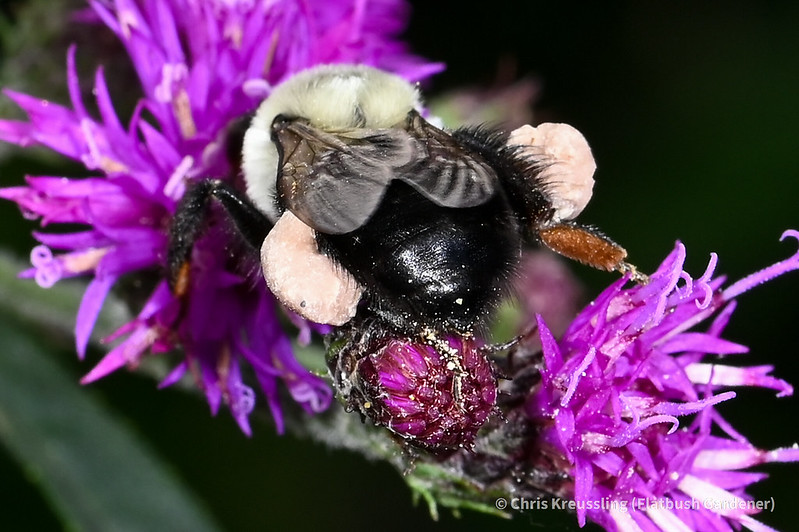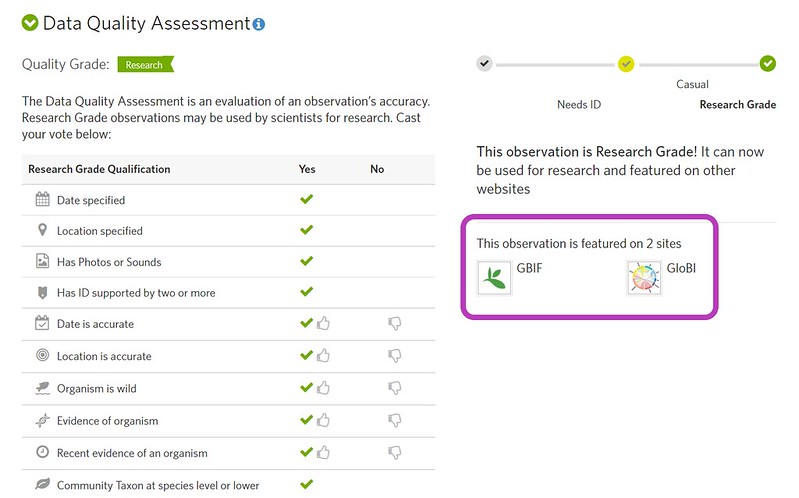I'm an active contributor to iNaturalist. While I'm not a "super-observer", I expect to surpass 11,000 Observations by Halloween, two days away.
Insect-Plant interactions are the majority of my iNaturalist Observations. I use the Observation Field: Interaction->Visited Flower Of to record which flowers insects are visiting, or lurking upon. Roughly 1/3 of my Observations use that field.

Both the Global Biodiversity Information Facility (GBIF) and Global Biotic Interactions database (GloBI) automatically import iNaturalist Research Grade observations with an appropriate Creative Commons license. I'll use one of my iNaturalist Observations as an example to show how it all works together.
In August I photographed an Eastern bumble bee, Bombus impatiens, on New York ironweed, Vernonia noveboracensis growing in my garden in front of my garage. Check out those bustling pink corbicula (pollen baskets)!

I uploaded that to iNaturalist as an Observation, and added the Observation Field "Interaction->Visited flower of: Vernonia noveboracensis New York Ironweed".

To make my Observations accessible for import into scientific databases, I assign the Creative Commons License Attribution-NonCommercial 4.0 International (CC BY-NC 4.0) to my iNaturalist Observations. Since enough time has passed since it reached iNaturalist Resarch Grade status, the Observation has since been imported into both GBIF and GloBI.

The iNaturalist Observation becomes a GBIF Occurrence. All fields are transcribed from iNat to corresponding GBIF fields, with some values interpreted, e.g.: GPS coordinates are rounded, GBIF Occurrence Status = "PRESENT".
To also make it into GloBI, the iNaturalist Observation also has to have one or more Observation Fields that GloBI recognizes. Per GloBI's "Contribute" page, their GitHub repo maps iNaturalist Observation Fields to GloBi's "Interaction Type". Any of the listed iNat Fields show up in GloBi with the corresponding "Interaction Type". There are already >170!

For example, Row 45 of that table shows that the iNaturalist Observation Field "Interaction: Visited flower of" corresponds to the GlobalBiotic Interaction Type "visits flowers of".
The GloBI link on my original iNaturalist Observation lists all iNat obs showing that:
- Bombus impatiens
- visits flowers of
- Vernonia noveboracensis
I seem to be the only person to have documented this interaction on iNat!
Related Content
Links
Data Sources
iNaturalistGlobal Biodiversity Information Facility (GBIF)
Global Biotic Interactions (GloBI)
Collections Management
Integrated Digitized Biocollections (iDigBio)Symbiota Collections of Arthropods Network (SCAN): provides a web-based collections database system for those that want to curate their data directly in SCAN and serve data to GBIF.
Data Standards
Biodiversity Information Standards (formerly known as the Taxonomic Databases Working Group, TDWG):- develops, ratifies and promotes standards and guidelines for the recording and exchange of data about organisms
- and acts as a forum for discussing all aspects of biodiversity information management through meetings, online discussions, and publications.
TDWG Biological Interaction Data Interest Group, GitHub Repo: https://github.com/tdwg/interaction
Darwin Core (DWC): Maintained by TDWG, a standard glossary of terms intended to facilitate the sharing of information about biological diversity by providing identifiers, labels, and definitions. Darwin Core is primarily based on taxa, their occurrence in nature as documented by observations, specimens, samples, and related information.
The Relations Ontology (RO) captures many species interaction terms (e.g., purl.obolibrary.org/obo/RO_0002455)

No comments:
Post a Comment